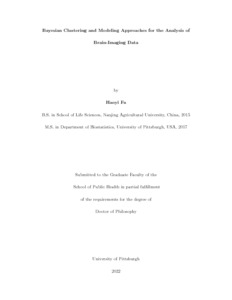Fu, Haoyi
(2023)
Bayesian Clustering and Modeling Approaches for the Analysis of Brain-Imaging Data.
Doctoral Dissertation, University of Pittsburgh.
(Unpublished)
This is the latest version of this item.
![[img]](http://d-scholarship.pitt.edu/43872/1.hassmallThumbnailVersion/ETD_HF_final.pdf)  Preview |
|
PDF (My final version of dissertation for formatting review)
Submitted Version
Download (9MB)
| Preview
|
Abstract
With the rapid development of modern techniques to measure functions and structures of the brain, statistical methods for analyzing brain-imaging data have become increasingly
important to the advancement of science. My dissertation focuses on developing Bayesian clustering and modeling approaches for brain-imaging data with application to a brain-imaging technique in particular: functional near-infrared spectroscopy (fNIRS).
In the first part, I propose a group-based approach to clustering univariate time series via a mixture of smoothing splines experts. Time-independent covariates are incorporated via the logistic weights of a mixture-of-experts model. I formulate the approach in a fully
Bayesian framework and conduct inference via reversible jump Markov chain Monte Carlo (RJMCMC) where the number of mixture components is assumed unknown. The superior
performance of the approach in terms of subgroup detection and estimation is demonstrated through both simulation studies and applications to the analysis of fNIRS data.
In the second part, the approach proposed in the first part is extended to the multivariate time series setting. Parameter estimation and inference are performed by Gibbs sampling, and the number of multivariate components is selected based on the deviance information criterion (DIC). The superior performance of the approach in terms of subgroup detection and estimation is demonstrated by simulation studies and applications to the analysis fNIRS
data.
In the final part, I propose a horseshoe prior-based generalized lasso for interpretable scalar on function regression. The approach is able to penalize regression coefficients with selected orders of differences by specifying appropriate prior structures. The horseshoe prior
is able to control both the global and local shrinkage levels of each coefficient simultaneously. The proposed method is demonstrated to have superior performance in terms of signal detection and prediction accuracy through simulation studies, and is applied to the analysis of fNIRS data.
Public Health Significance:
Developing model-based clustering and modeling approaches provides innovative statistical methods for the analysis of brain-imaging data, which overcome the challenges of
heterogeneity and high dimensionality. My proposed methods facilitate the discovery of underlying patterns of brain-imaging signals, as well as associations between these functional signals and clinical outcomes.
Share
| Citation/Export: |
|
| Social Networking: |
|
Details
| Item Type: |
University of Pittsburgh ETD
|
| Status: |
Unpublished |
| Creators/Authors: |
|
| ETD Committee: |
|
| Date: |
3 January 2023 |
| Date Type: |
Publication |
| Defense Date: |
8 December 2022 |
| Approval Date: |
3 January 2023 |
| Submission Date: |
18 November 2022 |
| Access Restriction: |
No restriction; Release the ETD for access worldwide immediately. |
| Number of Pages: |
168 |
| Institution: |
University of Pittsburgh |
| Schools and Programs: |
School of Public Health > Biostatistics |
| Degree: |
PhD - Doctor of Philosophy |
| Thesis Type: |
Doctoral Dissertation |
| Refereed: |
Yes |
| Uncontrolled Keywords: |
Bayesian mixture model, mixture-of-expert, multivariate analysis, smoothing splines, reversible jump MCMC, Gibbs sampling, brain-imaging; functional near-infrared spectroscopy, model-based clustering, face-to-face still-face, generalized lasso, horseshoe prior, orders of differences |
| Date Deposited: |
03 Jan 2023 15:56 |
| Last Modified: |
03 Jan 2023 15:56 |
| URI: |
http://d-scholarship.pitt.edu/id/eprint/43872 |
Available Versions of this Item
-
Bayesian Clustering and Modeling Approaches for the Analysis of Brain-Imaging Data. (deposited 03 Jan 2023 15:56)
[Currently Displayed]
Metrics
Monthly Views for the past 3 years
Plum Analytics
Actions (login required)
 |
View Item |








